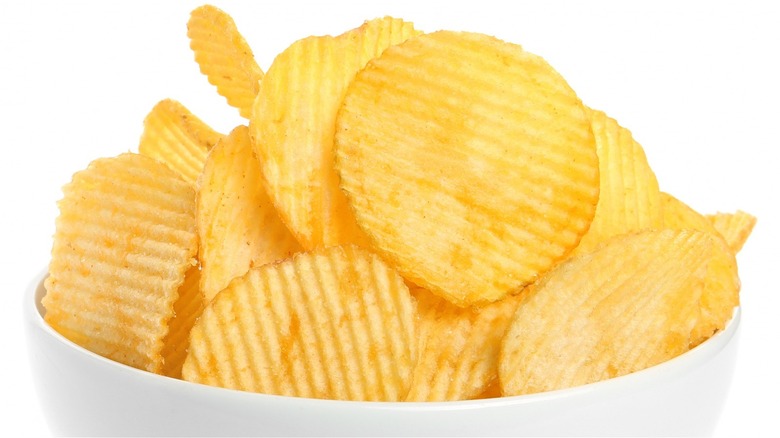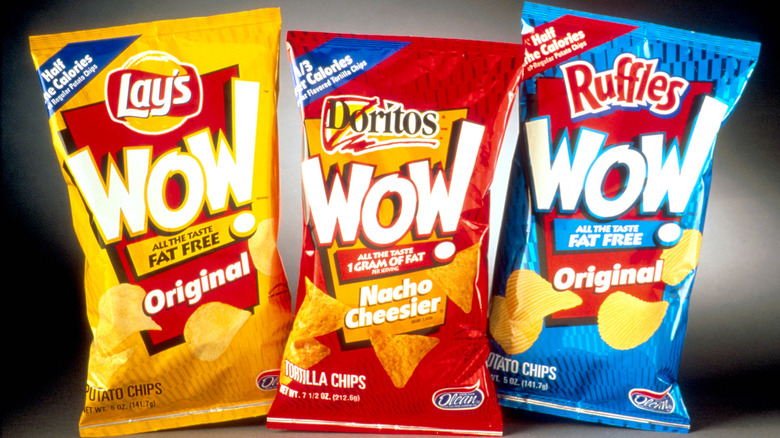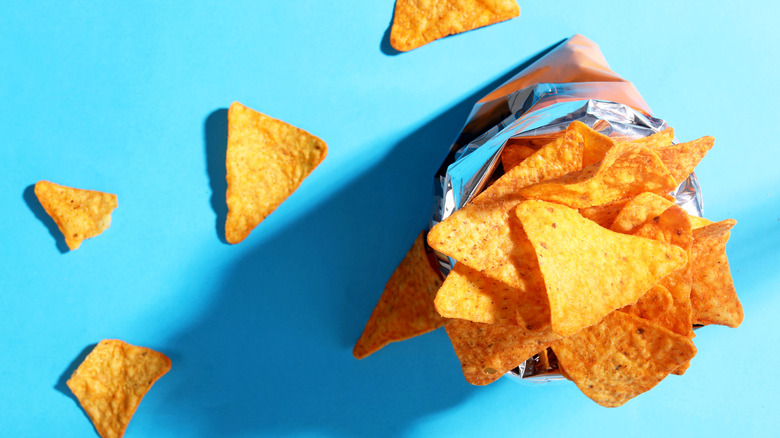The Sketchy Additive From The '90s That's Still In Your Favorite Snacks
Food and beverage companies using questionable chemical additives is not a not new issue. Think about high fructose corn syrup, for instance. This industrial additive was formulated to mostly replace sucrose due to its relatively low glycemic index, but it is no better. According to Cleveland Clinic, it boosts appetite, can cause obesity, and in serious cases, acts as a catalyst to cause type 2 diabetes, fatty liver, and inflammation.
When consumed excessively, food additives like artificial coloring, sodium nitrite, and trans fat can have a negative impact on our health. Some ingredients — like Potassium Bromate and Azodicarbonamide (ADA), Brominated Vegetable Oil (BVO), Titanium Dioxide, and certain food dyes — are banned in Europe, due to their potential carcinogenic effects, but they are widely used by companies in the United States.
Most of us aren't thinking about whether or not our favorite foods are laced with harmful additives when we buy them. But, it turns out that even foods marketed as healthier alternatives might not be safe. While your favorite fat-free snacks might keep you from gaining a few extra pounds, they may include a chemical that has a controversial history.
An additive that was too good to be true
In 1986, Procter & Gamble researchers Robert Volpenhein and Fred Mattson accidentally discovered the food additive olestra, a sucrose polyester blend that didn't break down at high temperatures. Not only could it be used as a replacement for fat in virtually any food, but olestra also had no calories and even helped flush cholesterol molecules out of the body.
In 1996, the FDA approved it as a food additive, and companies like Frito-Lay jumped at the opportunity to make fat-free "light" snacks for its weight-watching consumers. Some of your favorite snacks still contain olestra. Frito-Lay's Wow! reincarnated as Lays Light, and uses olestra as fat. Other snacks with the additive include fat-free Pringles, Doritos Light Nacho Cheese, Ruffles Light Original, and Ruffles Light Cheddar & Sour Cream.
Now, you might be wondering why olestra never made its way to our pantry shelves and why exactly did the critics not approve of the fat-free revolution in the first place. Most importantly, who would be so opposed to eating chips without all the bad stuff? However, according to CSPI, the additive can cause "diarrhea and loose stools, abdominal cramps, flatulence, and other adverse effects," and the symptoms can be "severe."
Olestra wasn't a revolution after all
All products containing olestra were required by the FDA to mention that the additive might cause gastrointestinal issues on their labels. Amid the raging criticism, P&G spent millions to open a plant to produce the additive and distribute it under the brand name Olean. Moreover, P&G did its best to market its product as all-natural. Frito-Lay's Wow! chips were a huge hit and made roughly $300 million in sales in 1999, but things were about to change as Americans realized olestra wasn't the only thing they couldn't digest.
More and more studies concluded that olestra caused gastrointestinal issues, and olestra products slowly lost their market appeal. The additive was said to reduce the body's ability to absorb essential vitamins and nutrients, and the high prices of olestra products didn't help, either. "We acknowledge the current performance isn't what we would have liked," a P&G spokesperson said back then, per The New York Times.
Although the FDA initially required olestra-based products to be labeled, it dropped the requirement in 2003. Regardless, growing criticism slowly drove America to cold-shoulder olestra, and the sales dwindled. In 2010, TIME Magazine even ranked it as "one of the worst inventions" of all time.


